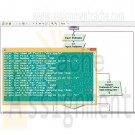Search results for 'eco'
-

Assignment 1 Frans Virtual Fruit Stand Part 1
$12.00Assignment 1 Fran’s Virtual Fruit Stand, Part 1
Fran’s Virtual Fruit Stand is an online store that sells several types of dried fruit. Based on the needs of Fran’s Virtual Fruit stand, you must design a flowchart using Visual Logic. The flowchart must also be a fully functional program which follows the design requirements below.
Note: This program does not require the use of arrays. The program will prompt for data on a single item, process that data, display any relevant messages as described below, and then move on to the next item. Use the “console” option in the output command to display the output in a single window. Displaying the output can be accomplished with as few as three (3) variables that simply get overwritten each time the loop repeats.
Using Visual Logic, design a flowchart that is also a fully functional program. According to your design, the program must:
Continually accept data regarding the purchase of fruit until a sentinel value is entered.
Prompt the user for each item, and accept the name of the fruit (e.g., “dried apples”), the price per pound, and the number of pounds sold in a month.
Display a clear message for items that are considered:
Best-selling items
Note: Best-selling items are identified as those that sell 5,000 or more pounds per month on average. For example, an acceptable message may read, “Yellow raisins are a best-selling item.”Big-ticket items
Note: Big-ticket items are identified as those that are best-selling items and also cost $4 per pound or more. For example, an acceptable message may read, “Freeze-dried blueberries are a big-ticket item.”High-priced items
Note:High-priced items are identified as those that sell for $7 per pound or more. For example, an acceptable message may read, “Dried mangos are a high-priced item.”Lowest-selling items
Note: Lowest-selling items are identified as those that sell 500 pounds or less per month on average. For example, an acceptable message may read, “Dried Ugli Fruit is a lowest-selling item.”High-income generating items
Note: High-income generating items are identified as those that generate $7,000 or more per month on average. To determine the income generated per item, multiply the price per pound by the number of pounds sold per month. If the item generates $7,000 or more per month, an acceptable message may read, “Dried pineapple chunks are a high-income generating item.”Loop through all of the above steps until the user types the sentinel value when prompted. Display the sentinel value so that the user may ultimately be able to demonstrate an understanding of the way in which to end the program. Note: An acceptable message may read “Type n to end the program.”, where “n” is the sentinel value.
Your Visual Logic program must follow these formatting requirements:
Be accomplished in a single Visual Logic program.
Be submitted as a single file with the “.vls” file extension.
Be fully functional in order to receive full credit.
Learn More
The specific course learning outcomes associated with this assignment are:
Demonstrate the use of algorithms and pseudocoding to the problem-solving process.
Distinguish among the basic types, steps, and properties of programming.
Apply the techniques of functional decomposition, modularization techniques, and debugging strategies into program design.
Describe the features and fundamental data structures of programming design.
Select and create the appropriate conditional and iteration constructs for a given programming task. -

CMIS 102 Assignment 2 build a state-of-the-art gaming computer
$12.00CMIS 102 Assignment 2 build a state-of-the-art gaming computer
Design a program to perform the following task:
Calculate the total price to purchase all the components required to build a state-of-the-art gaming computer from components available on the internet.[Hints: Before attempting this exercise, be sure you have completed all of chapter 3 and course module readings, participated in the weekly conferences, and thoroughly understand the examples throughout the chapter. As before, there are 3 main components of your submission including the problem analysis, program design and documentation, and sample test data.]
Part 1: Analysis [5 points]
Using a similar approach as example 3.6 (textbook page 146): “A new Car Price Calculator”, provide your analysis for the following problem statement: You need to write a program that will calculate the total price to purchase all the components required to build a state-of-the-art gaming computer from newegg.com. You will need to conduct some analysis on newegg.com (or amazon.com) regarding the possible options and prices to be considered. However; assume the computer will consist of the following components:CPU
Case
Power supply
Motherboard
Hard Drive
RAM
DVD
Sound Card
Monitor
Graphics Card
Operating SystemI would recommend you keep the option choices limited to 3 different components, or your program will really grow fast. For example, you could provide options for the Operating System (Windows 7, Red Hat Linux), the RAM (4 MB, 8 MB, 12 MB) and the Hard Drive Size (500 GB, 1 TB, 1.5 TB) and leave everything else as a baseline. I leave it up to you to determine which components you want to add options for and for researching the approximate prices. Be sure your prices are fairly realistic.
Your analysis should be clearly written and demonstrate your thought process and steps used to analyze the problem. Be sure to include what is the required output? What is the necessary input and how you will obtain the required output from the given input? Also, include your variable names and definitions. Be sure to describe the necessary formulas and sample calculations that might be needed.Part 2: Design [5 points]
Using a similar approach as example 3.6 (textbook page 146): “A new Car Price Calculator”, provide your program design for the program you analyzed for calculating the total price of your gaming computer. Be sure to describe the fundamental tasks (i.e., things your program must do) needed to solve the problem so you can use a modular design. Provide pseudocode of your overall design that includes the Main module and the order of the module calls (see page 148 for an example) and a Hierarchy chart for the computer price calculator (see figure 3.8 page 148). Finally, list all of your pseudocode for each module. (See pages148-150 as an example.)Include header and step comments in your pseudocode, using a similar approach as the example provided in section 2.3 (textbook page 86). See example 2.8 on pages 87-88).
Part 3: Test Data [3 points]
Learn More
Prepare at least 5 sets of input data (Test data) along with their expected output for testing your program. Your test data can be presented in the form of a table as was shown in Assignment 1. Be sure that you provide expected output for each test case.



